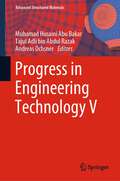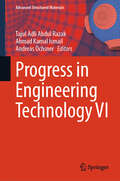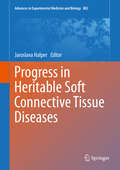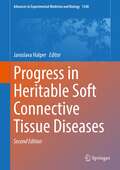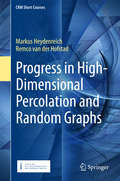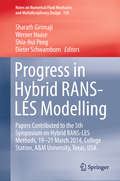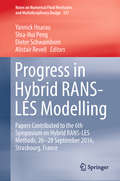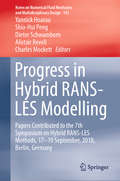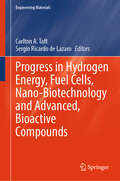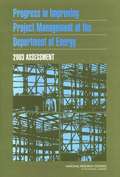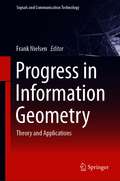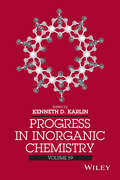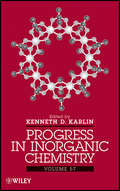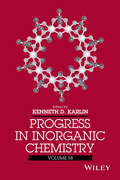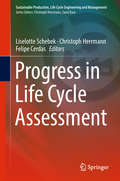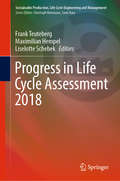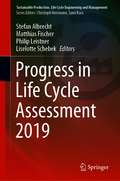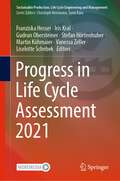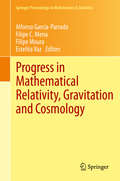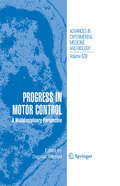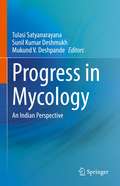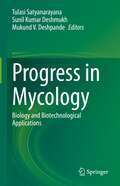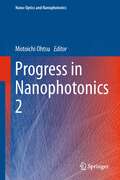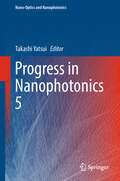- Table View
- List View
Progress in Engineering Technology V (Advanced Structured Materials #183)
by Andreas Öchsner Muhamad Husaini Abu Bakar Tajul Adli bin Abdul RazakThe book contains a selection of peer-reviewed papers from the 2022 conferences, which took place at the Universiti Kuala Lumpur, Malaysian Spanish Institute (UniKL MSI), Kedah, Malaysia. This book contains twenty-two papers written by researchers participating in the conferences. Topics covered in this book include composite materials, thermodynamics, vibration, dynamics of structures, manufacturing processes, computer-aided manufacturing, CFD analysis, design and optimization of devices, and procedures. The topics are commonly encountered in industries and become an interest in the academic world. The learning of engineering technology’s curricular across universities is now an essential topic covered in various higher learning institutions. Therefore, it is hoped that this book serves as an excellent reference for researchers and graduate students working with/on multidisciplinary engineering technology.
Progress in Engineering Technology VI (Advanced Structured Materials #229)
by Tajul Adli Abdul Razak Ahmad Kamal Ismail Andreas ÖchsnerThis book features 31 studies that collectively explore a wide range of innovative engineering solutions and advanced technologies across various fields. Most of the studies focus on designing, analyzing, and optimizing systems that improve efficiency and performance. The papers highlight cutting-edge methodologies and applications, from hydro turbine installations in underground pipelines to using nanofluids for CPU cooling. Key projects include the development of autonomous vehicles for flood detection, innovative composites for automotive applications, and advanced monitoring systems for industrial machinery. Together, these contributions tackle real-world challenges and expand the horizons of engineering practices, emphasizing the significance of interdisciplinary research in delivering impactful solutions for the future.
Progress in Environmental Engineering: Water, Wastewater Treatment and Environmental Protection Issues
by Piotr Koszelnik Janusz A. TomaszekProgress in Environmental Engineering contains theoretical and experimental contributions on water purification, new concepts andmethods of wastewater treatment, and ecological problems in freshwater ecosystems. The issues dealt with in the book include:(i) Causes and control of activated sludge bulking and foaming(ii) e use of new support material
Progress in Heritable Soft Connective Tissue Diseases
by Jaroslava HalperThis volume is a reference handbook focusing on diseases like Marfan syndrome, Ehlers-Danlos syndrome, Loeys-Dietz syndrome and other heritable soft connective tissue diseases. The book presents detailed information for both basic scientists and for clinicians seeing patients. It is also a stepping stone for new investigations and studies that goes beyond the facts about the composition and biochemistry of the connective tissue and extracellular matrix, as the authors connect individual components to specific aspects of various soft tissue disorders and to the actual or potential treatment of them. Progress in Heritable Soft Connective Tissue Diseases features very prominent physicians and scientists as contributors who bring their most recent discoveries to the benefit of readers. Their expertise will help clinicians with proper diagnosis of sometimes elusive and uncommon heritable diseases of soft connective tissues. This book also offers an update on the pathophysiology of these diseases, including an emphasis on unifying aspects such as connections between embryonic development of the different types of connective tissues and systems, and the role of TGF-beta in development and physiology of soft tissues. This new set of data explains, at least in part, why many of these disorders are interconnected, though the primary pathophysiological events, such as gene mutations, may be different for each disorder.
Progress in Heritable Soft Connective Tissue Diseases (Advances in Experimental Medicine and Biology #1348)
by Jaroslava HalperThis volume represents a substantially revised and updated 2nd edition of a reference handbook on major structural components of soft connective tissues and a whole slew of heritable diseases of soft connective tissues. The number of clearly identifiable and distinct disorders has grown somewhat since the 1st edition in 2014, e.g., Ehlers-Danlos syndrome has now 13 entities. A brand new syndrome, Meester Loeys syndrome carrying the name of Bart Loeys was added as a companion to Loeys-Dietz syndrome. Numerous variations of cutis laxa and joint mobility disorders have been discovered taking advantage of recent advancements in genetic analysis. We have acquired better understanding of pathogenesis and biochemical changes in some other, more established entities, such as Marfan and collagen VI myopathies where better management and possible treatment are on the horizon. Even in the case of connective tissue diseases in domestic animals some progress has been made. All these updates were contributed by a group of distinguished and preeminent physicians and scientists, all of them not just working in the field but making new discoveries described by them.Readers will notice that seemingly there is an overlap among many of these disorders. And indeed, many of them, if not most are interconnected because of the prominent roles of TGFβ, of fibrillin microfibrils and collagen fibril assembly (and other molecules) playing in connective tissues physiology, and by extension in pathogenesis of many disorders described in the book. What I found particularly helpful that author(s) of each chapter bring their own perspective even when described closely related mechanism of the disease. These observations should help with diagnosis and management of such cases.The first chapters are more general, concentrating more on the physiology, structure and biochemistry of normal soft tissues. That should help in better understanding of the pathophysiology. Last but not least, the chapters are very readable, more like detective stories than dry description of genetic/biochemical defects. I do hope that basic scientists and clinicians with similar and diverse interests alike will appreciate this volume and will be inspired by it to develop their research in the field.
Progress in High-Dimensional Percolation and Random Graphs
by Remco van der Hofstad Markus HeydenreichThis text presents an engaging exposition of the active field of high-dimensional percolation that will likely provide an impetus for future work. With over 90 exercises designed to enhance the reader's understanding of the material, as well as many open problems, the book is aimed at graduate students and researchers who wish to enter the world of this rich topic. The text may also be useful in advanced courses and seminars, as well as for reference and individual study. Part I, consisting of 3 chapters, presents a general introduction to percolation, stating the main results, defining the central objects, and proving its main properties. No prior knowledge of percolation is assumed. Part II, consisting of Chapters 4-9, discusses mean-field critical behavior by describing the two main techniques used, namely, differential inequalities and the lace expansion. In Parts I and II, all results are proved, making this the first self-contained text discussing high-dime nsional percolation. Part III, consisting of Chapters 10-13, describes recent progress in high-dimensional percolation. Partial proofs and substantial overviews of how the proofs are obtained are given. In many of these results, the lace expansion and differential inequalities or their discrete analogues are central. Part IV, consisting of Chapters 14-16, features related models and further open problems, with a focus on the big picture.
Progress in Hybrid RANS-LES Modelling
by Sharath Girimaji Werner Haase Shia-Hui Peng Dieter SchwambornThis book gathers the proceedings of the Fifth Symposium on Hybrid RANS-LES Methods, which was held on March 19-21 in College Station, Texas, USA. The different chapters, written by leading experts, reports on the most recent developments in flow physics modelling, and gives a special emphasis to industrially relevant applications of hybrid RANS-LES methods and other turbulence-resolving modelling approaches. The book addresses academic researchers, graduate students, industrial engineers, as well as industrial R&D managers and consultants dealing with turbulence modelling, simulation and measurement, and with multidisciplinary applications of computational fluid dynamics (CFD), such as flow control, aero-acoustics, aero-elasticity and CFD-based multidisciplinary optimization. It discusses in particular advanced hybrid RANS-LES methods. Further topics include wall-modelled Large Eddy Simulation (WMLES) methods, embedded LES, and a comparison of the LES methods with both hybrid RANS-LES and URANS methods. Overall, the book provides readers with a snapshot on the state-of-the-art in CFD and turbulence modelling, with a special focus to hybrid RANS-LES methods and their industrial applications.
Progress in Hybrid RANS-LES Modelling: Papers Contributed To The 5th Symposium On Hybrid Rans-les Methods, 19-21 March 2014, College Station, A&m University, Texas, Usa (Notes On Numerical Fluid Mechanics And Multidisciplinary Design Ser. #130)
by Shia-Hui Peng Dieter Schwamborn Yannick Hoarau Alistair RevellThis book reports on the latest developments in computational fluid dynamics and turbulence modeling, with a special emphasis on hybrid RANS-LES methods and their industrial applications. It gathers the proceedings of the Sixth Symposium on Hybrid RANS-LES Methods, held on September 26-28 in Strasbourg, France. The different chapters covers a wealth of topics such as flow control, aero-acoustics, aero-elasticity and CFD-based multidisciplinary optimization. Further topics include wall-modelled Large Eddy Simulation (WMLES), embedded LES, Lattice-Bolzman methods, turbulence-resolving applications and comparisons between LES, hybrid RANS-LES and URANS methods. The book addresses academic researchers, graduate students, industrial engineers, as well as industrial R&D managers and consultants dealing with turbulence modelling, simulation and measurement, and with multidisciplinary applications of computational fluid dynamics.
Progress in Hybrid RANS-LES Modelling: Papers Contributed to the 7th Symposium on Hybrid RANS-LES Methods, 17–19 September, 2018, Berlin, Germany (Notes on Numerical Fluid Mechanics and Multidisciplinary Design #143)
by Shia-Hui Peng Dieter Schwamborn Charles Mockett Yannick Hoarau Alistair RevellThis book gathers the proceedings of the Seventh Symposium on Hybrid RANS-LES Methods, which was held on September 17-19 in Berlin, Germany. The different chapters, written by leading experts, reports on the most recent developments in flow physics modelling, and gives a special emphasis to industrially relevant applications of hybrid RANS-LES methods and other turbulence-resolving modelling approaches. The book addresses academic researchers, graduate students, industrial engineers, as well as industrial R&D managers and consultants dealing with turbulence modelling, simulation and measurement, and with multidisciplinary applications of computational fluid dynamics (CFD), such as flow control, aero-acoustics, aero-elasticity and CFD-based multidisciplinary optimization. It discusses in particular advanced hybrid RANS-LES methods. Further topics include wall-modelled Large Eddy Simulation (WMLES) methods, embedded LES, Lattice-Bolzman methods and turbulence-resolving applications and a comparison of the LES methods with both hybrid RANS-LES and URANS methods. Overall, the book provides readers with a snapshot on the state-of-the-art in CFD and turbulence modelling, with a special focus to hybrid RANS-LES methods and their industrial applications.
Progress in Hydrogen Energy, Fuel Cells, Nano-Biotechnology and Advanced, Bioactive Compounds (Engineering Materials)
by Carlton A. Taft Sergio Ricardo de LazaroFrom cutting-edge quantum dots poised to revolutionize energy, health, and environmental sectors to the intricate design and characterization of perovskite-based solar cells, this comprehensive volume delves into the forefront of materials science and technology. Offering both theoretical depth and practical insights, it explores the latest advancements in fuel cells, spintronics, and quantum computing materials. Furthermore, it scrutinizes the mesmerizing realm of magnetism, phonon dynamics, and thermophysical properties through a detailed examination of gamma-Fe4N. Seamlessly integrating theory with experimentation, this book serves as an indispensable resource for researchers, engineers, and enthusiasts navigating the dynamic landscape of modern materials innovation.
Progress in Improving Project Management at the Department of Energy: 2003 Assessment
by Committee for Oversight Assessment of U.S. Department of Energy Project ManagementIn 1997, Congress, in the conference report, H.R. 105-271, to the FY1998 Energy and Water Development Appropriation Bill, directed the NRC to carry out a series of assessments of project management at the Department of Energy (DOE). This report, the 2003 Assessment, is the final one in that series. It presents an examination of DOE's progress in improving program management over the past three years including the Department's response to the recommendations of the previous assessments in this series. In addition to assessing DOE’s progress, the report also describes opportunities for further improvement and gives a prognosis for future developments.
Progress in Information Geometry: Theory and Applications (Signals and Communication Technology)
by Frank NielsenThis book focuses on information-geometric manifolds of structured data and models and related applied mathematics. It features new and fruitful interactions between several branches of science: Advanced Signal/Image/Video Processing, Complex Data Modeling and Analysis, Statistics on Manifolds, Topology/Machine/Deep Learning and Artificial Intelligence. The selection of applications makes the book a substantial information source, not only for academic scientist but it is also highly relevant for industry. The book project was initiated following discussions at the international conference GSI’2019 – Geometric Science of Information that was held at ENAC, Toulouse (France).
Progress in Inorganic Chemistry
by Kenneth D. KarlinPROGRESS in Inorganic ChemistryThe cutting edge of scientific reportingNowhere is creative scientific talent busier than in the world of inorganic chemistry experimentation. Progress in Inorganic Chemistry continues in its tradition of being the most respected avenue for exchanging innovative research. This series provides inorganic chemists and materials scientists with a forum for critical, authoritative evaluations of advances in every area of the discipline. With contributions from internationally renowned chemists, this latest volume offers an in-depth, far-ranging examination of the changing face of the field, providing a tantalizing glimpse of the emerging state of the science."This series is distinguished not only by its scope and breadth, but also by the depth and quality of the reviews." -Journal of the American Chemical Society"[This series] has won a deservedly honored place on the bookshelf of the chemist attempting to keep afloat in the torrent of original papers on inorganic chemistry." -Chemistry in BritainCONTENTS OF VOLUME 57Mechanisms of Water Oxidation Catalyzed by Ruthenium Coordination Complexes (Aurora E. Clark and James K. Hurst)Biomimetic and non-biological dinuclear Mx+-complex catalyzed alcoholysis reactions of phosphoryl transfer reactions (R. Stan Brown)Photoactivated DNA Cleavage and Anticancer Activity of 3d-Metal Complexes (Akhil R. Chakravarty and Mithun Roy)Design and Evolution of Artificial Metalloenzymes: Biomimetic Aspects (Marc Creus and Thomas R.Ward)Functionalization of Fluorinated Aromatics by Nickel-Mediated C-H and C-F Bond Oxidative Addition: Prospects for the Synthesis of Fluorine-Containing Pharmaceuticals (Samuel A. Johnson, Jillian A. Hatnean, Meghan E. Doster)DNA-Based Metal Catalysis (Jens Oelerich and Gerard Roelfes)Metallo-lactamases and their Synthetic Mimics: Structure, Function and Catalytic Mechanism (Muthaiah Umayal, A. Tamilselvi, and Govindasamy Mugesh)A New Class of Nanostructured Inorganic-Organic Hybrid Semiconductors Based on II-VI Binary Compounds (Jing Li and Ruibo Zhang)Oxygen Evolution Reaction Chemistry of Oxide-Based Electrodes (Yogesh Surendranath and Daniel G. Nocera)
Progress in Inorganic Chemistry (Progress in Inorganic Chemistry #113)
by Kenneth D. KarlinThis series provides inorganic chemists and materials scientists with a forum for critical, authoritative evaluations of advances in every area of the discipline. Volume 57 continues to report recent advances with a significant, up-to-date selection of contributions from internationally-recognized researchers. The chapters of this volume are devoted to the following topics: Mechanisms of Water Oxidation Catalyzed by Ruthenium Coordination Complexes; Biomimetic and non-biological dinuclear Mx+-complex catalyzed alcoholysis reactions of phosphoryl transfer reactions; Photoactivated DNA Cleavage and Anticancer Activity of 3d-Metal Complexes; and more.
Progress in Inorganic Chemistry (Progress in Inorganic Chemistry #115)
by Kenneth D. KarlinThis series provides inorganic chemists and materials scientists with a forum for critical, authoritative evaluations of advances in every area of the discipline. Volume 58 continues to report recent advances with a significant, up-to-date selection of contributions by internationally-recognized researchers. The chapters of this volume are devoted to the following topics: • Tris(dithiolene) Chemistry: A Golden Jubilee • How to find an HNO needle in a (bio)-chemical Haystack • Photoactive Metal Nitrosyl and Carbonyl Complexes Derived from Designed Auxiliary Ligands: An Emerging Class of Photochemotherapeutics • Metal--Metal Bond-Containing Complexes as Catalysts for C--H Functionalization Iron Catalysis in Synthetic Chemistry • Reactive Transition Metal Nitride Complexes Suitable for inorganic chemists and materials scientists in academia, government, and industries including pharmaceutical, fine chemical, biotech, and agricultural.
Progress in Life Cycle Assessment (Sustainable Production, Life Cycle Engineering and Management)
by Christoph Herrmann Liselotte Schebek Felipe CerdasThe book contains the latest developments in the field of life cycle assessment (LCA) and its application. It contains numerous research articles from leading German research institutes working towards the further development of the methodology. The book provides important insights for professionals working in the field of sustainability assessment, for researchers interested in the current state of the research of the methodology and its application as well as for advanced university students in different science and engineering fields.
Progress in Life Cycle Assessment 2018 (Sustainable Production, Life Cycle Engineering and Management)
by Maximilian Hempel Liselotte Schebek Frank TeutebergThis book comprises recent developments in life cycle assessment (LCA) both with regards to the methodology and its application in various research fields, including mobility, engineering and manufacturing. Containing numerous original research articles from leading German research institutes, the book provides an insightful resource for professionals working in the field of sustainability assessment, for researchers interested in the current state of LCA research as well as for advanced university students in different scientific and engineering fields.
Progress in Life Cycle Assessment 2019 (Sustainable Production, Life Cycle Engineering and Management)
by Liselotte Schebek Matthias Fischer Stefan Albrecht Philip LeistnerThis book covers the latest developments in life cycle assessment LCA both in terms of methodology and its application in various research areas. It includes methodological questions as well as case studies concerning energy and mobility, materials and engineering, sustainable construction and future technologies. With numerous research articles from leading German and Austrian research institutes, the book is a valuable source for professionals working in the field of sustainability assessment, researchers interested in the current state of LCA research, and advanced university students in various scientific and technical fields.Chapter “Life Cycle Assessment of a Hydrogen and Fuel Cell RoPax Ferry Prototype” is available open access under a Creative Commons Attribution 4.0 International License via link.springer.com.
Progress in Life Cycle Assessment 2021 (Sustainable Production, Life Cycle Engineering and Management)
by Liselotte Schebek Franziska Hesser Iris Kral Gudrun Obersteiner Stefan Hörtenhuber Martin Kühmaier Vanessa ZellerThis book covers the latest developments in life cycle assessment (LCA) both in terms of methodology and its application in various research areas. It includes methodological questions as well as case studies of strategies in the context of circular economy and new emerging technologies, design of conceptual frameworks, especially related to social LCA, and the use of novel modeling approaches with a focus on energy supply and land use. With research articles from leading German and Austrian research institutes, the book is a valuable source for professionals working in the field of sustainability assessment, researchers interested in the current state of LCA research, and advanced university students in various scientific and technical fields. 6 chapters are available open access under a Creative Commons Attribution 4.0 International License via link.springer.com.
Progress in Mathematical Relativity, Gravitation and Cosmology
by Alfonso García-Parrado Filipe C. Mena Filipe Moura Estelita VazThis book contains contributions from the Spanish Relativity Meeting, ERE 2012, held in Guimarães, Portugal, September 2012. It features more than 70 papers on a range of topics in general relativity and gravitation, from mathematical cosmology, numerical relativity and black holes to string theory and quantum gravity. Under the title "Progress in Mathematical Relativity, Gravitation and Cosmology," ERE 2012 was attended by an exceptional international list of over a hundred participants from the five continents and over forty countries. ERE is organized every year by one of the Spanish or Portuguese groups working in this area and is supported by the Spanish Society of Gravitation and Relativity (SEGRE). This book will be of interest to researchers in mathematics and physics.
Progress in Motor Control
by Dagmar SternadThis ground-breaking book brings together researchers from a wide range of disciplines to discuss the control and coordination of processes involved in perceptually guided actions. The research area of motor control has become an increasingly multidisciplinary undertaking. Understanding the acquisition and performance of voluntary movements in biological and artificial systems requires the integration of knowledge from a variety of disciplines from neurophysiology to biomechanics.
Progress in Mycology: An Indian Perspective
by Tulasi Satyanarayana Sunil Kumar Deshmukh Mukund V. DeshpandeIndian mycologists have extensively studied various groups of fungi such as soil fungi, aquatic fungi, marine fungi, endophytic fungi, fungi associated with man and animals. Though several books on various aspects of fungi are published, this is the first account of the history and developments in mycology in India. It discusses at length various stages of development of mycology including both classical and biotechnological aspects. It begins with a historical account of Indian mycology, followed by a description of research on fossil fungi. Further chapters cover the latest updates on different taxonomic groups of fungi. A dedicated section describes the roles and applications of fungal endophytes. The book also includes research in other important areas such as mushrooms and wood rotting fungi. Different chapters are written by leading mycologists. This book is useful to students, teachers and researchers in botany, microbiology, biotechnology and life sciences, agriculture and industries using fungi to produce various valuable products.
Progress in Mycology: Biology and Biotechnological Applications
by Tulasi Satyanarayana Sunil Kumar Deshmukh Mukund V. DeshpandeIndian mycologists have extensively studied various groups of fungi such as soil fungi, aquatic fungi, marine fungi, endophytic fungi, fungi associated with man and animals. Though several books on various aspects of fungi are published, this is the first account of the history and development in mycology in India. This book is the second volume of the two-volume book "Progress in Mycology: An Indian Perspective". While volume 1 contains the historical aspects, taxonomy and information about the various groups of fungi, this volume focuses majorly on the biotechnological applications of the different groups of fungi. It discusses topics such as the extremophilic fungi, the history and development in Candida research, progress of mycotoxin research in India etc. It provides a detailed account of the various enzymes and bio-active molecules derived from fungi. India shows a very high biodiversity of fungi, and this book discusses these different group of fungi and their industrial and biotechnological applications. This book is useful to students, teachers and researchers in botany, microbiology, biotechnology and life sciences, agriculture and industries using fungi to produce various valuable products.
Progress in Nanophotonics 2
by Motoichi OhtsuThis book focuses the recent progress in nanophotonics technology to be used to develop novel nano-optical devices, fabrication technology, and advanced systems. It begins with a review of near-field excitation dynamics in molecules. Further topics include: wavelength up-converting a phonon-assisted excitation process with degenerate beams and non-degenerate beams in dye grains, a fabrication method of semiconductor quantum dots including self-assembly of InAs quantum dots based on the Stranski-Krastanov growth mode, single-nanotube spectroscopy and time-resolved spectroscopy for studying novel excitonic properties of single-walled carbon nanotubes. The striking features of ecxitons in the carbon nanotube, multiple-exciton states, and microfluidic and extended-nano fluidic techniques. These topics are reviewed by nine leading scientists. This overview is a variable resource for engineers and scientists working in the field of nanophotonics.
Progress in Nanophotonics 5 (Nano-Optics and Nanophotonics)
by Takashi YatsuiThis book presents important topics in nanophotonics in review-style chapters written by world leading scientists. The book sketches the history of dressed photon science and technology and explains why advanced theories of dressed photons are required. To meet this requirement, the recent results of theoretical studies and the theory of dressed photons are displayed by modifying the conventional electromagnetic theory. The classical theoretical model of spatiotemporal vortex dynamics is explained by treating the dressed photon as a space-like virtual photon. Also discussed in the book is the energy transfer of dressed photons, based on a quantum walk model and a quantum mechanical measurement process of dressed photons for connecting the nano- and macro-systems. Dressed photons are explained as quantum fields by characterizing them in momentum space.
